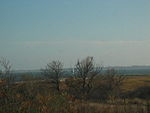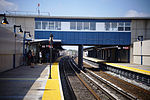Sandy Neck Beach is a barrier beach (sandstone) that stretches 6.5 miles (10.6 kilometers) long and one half-mile (800 m) wide. along Cape Cod Bay, backed along its entire length by undulating dunes and a picturesque salt marsh. It is a destination for all leisure activities: summer swimming, year-round hiking, and saltwater fishing. The dunes, which reach 100 ft. hight, are a habitat for red foxes, deers,shorebirds and wildflowers. From four points along the coast, walking paths cross the dunes inland to a path that bypasses the salt marsh. The beach access road is halfway between Sandwich and Barnstable on MA 6A. Near the eastern end of the shoal, on the low and eastern point of Sandy Neck, at the entrance to Barnstable Harbor, stands the Sandy Neck Lighthouse(n), which is more than a 150 years old, and next to it is the six-room keeper's house.
In the Nineteenth Century, Barnstable was an essential port for fishing, whaling, and coastal trade, and Sandy Neck was home to the laborers who tried to turn the port into oil drilling. On May 18, 1826, the congress authorized $3,500 for a lighthouse at the east end of Sandy Neck, at a point known as Beach Point. In a show of support, Barnstable sold a two-acre parcel of real estate for just one dollar to construct the lighthouse. On October 1, 1826, the Sandy Neck Lighthouse, which cost $2,911 then, went into service. In 1857, The current brick lighthouse 48-foot tall (14.5 meters) was built, just north of the original house. In 1887, two iron hoops and six vertical bars were placed around the central part of the "heavily cracked" tower to strengthen it and prevent further decay. These hoops and poles remained, giving the Sandy Neck Lighthouse its unique appearance. The history of the lighthouse is recorded until the 1950s. In 2003, the committee for the restoration of the Sandy Neck Lighthouse was established to restore the tower to its proper appearance, with the assistance of the Cape Cod branch of the American Lighthouse Foundation.
On October 20, 2007, the 150th anniversary of the current tower built in 1857, a group of supporters aboard a "Hyannis Whale Watch" vessel was seen removing the cover from the lighthouse's searchlight room, allowing the Sandy Point Beacon to shine again. Fireworks display behind the lighthouse concluded the evening. The station's oil house, built in 1905, was restored in 2008, and in 2010 a light emitting diode (LED) beacon was installed in the searchlight room, increasing the range of the light from 4.2 to 10.4 nautical miles.
Sandy Neck Colony still sits near the edge of Sandy Neck, with about two dozen cottages, many of which are more than a century old. One of the first cottages was used as a restaurant. The beach itself is public and it is one of the most popular locations on Cape Cod. Every year an average of 120,000 to 150,000 visitors flock to Sandy Neck, many via all-terrain vehicles.












